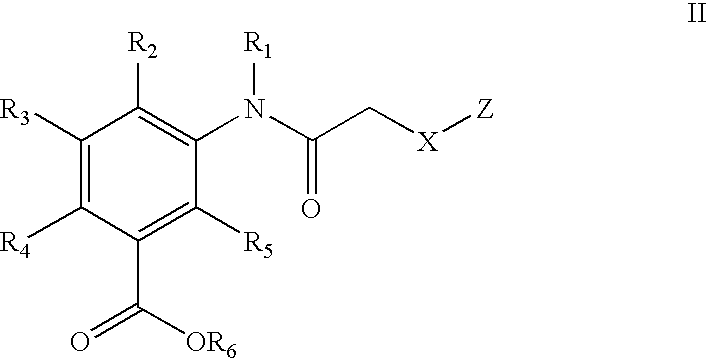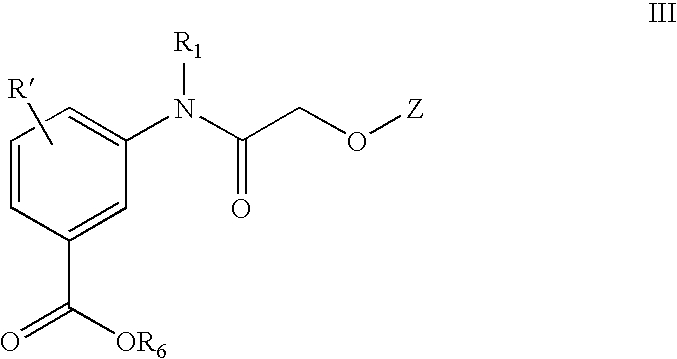Acetylamino benzoic acid compounds and their use for nonsense suppression and the treatment of disease
a technology compound, applied in the field of acetylamino benzoic acid compounds, can solve the problems of many amino acid substitutions that do not have a gross effect on protein structure or function, major disruption of the genome, and inability to produce aberrant proteins in cells, so as to minimize the spread or worsening of disease.
- Summary
- Abstract
- Description
- Claims
- Application Information
AI Technical Summary
Benefits of technology
Problems solved by technology
Method used
Image
Examples
example 1
5.1 Example 1
SYNTHESIS OF 3-[2-(4-ISOPROPYL 3-METHYL-PHENOXY)-ACETYLAMINO]-BENZOIC ACID
[0372]A solution of methyl 3-aminobenzoate (10.0 g, 66.2 mmol) and diisopropylethylamine (13.0 mL, 74.6 mmol) in tetrahydrofuran (100 mL) was cooled to 0° C. under inert atmosphere, and a solution of bromoacetyl bromide (6.3 mL, 72.3 mmol) in tetrahydrofuran (50 mL) was added dropwise with stirring. After 12 h, the mixture was partitioned between water and ethyl acetate (200 mL each), and separated. The organic phase was washed with water and brine, and the aqueous phases were back-extracted in sequence with ethyl acetate. The organic extracts were combined, dried over anhydrous magnesium sulfate, filtered and evaporated. The residue was triturated with ether and collected by filtration to afford, after vacuum drying, the product, 3-(2-bromo-acetylamino)-benzoic acid methyl ester, as a solid, m.p. 91–92° C. (14.05 g, 51.6 mmol, 78%). TLC RF 0.18 (30:70 ethyl acetate-hexane). 1H NMR (300 MHz, CDCl3...
example 2
5.2 Example 2
SYNTHESIS OF 3-[2-(4-ISOPROPYL-3-METHYL-PHENOXY)-THIOACETYLAMINO]-BENZOIC ACID
[0375]A solution of methyl 3-[2-(4-isopropyl-3-methyl-phenoxy)acetylamino]benzoate (1.05 g, 3.08 mmol) in toluene (50 mL) was treated with 2,4-bis(4-methoxyphenyl)-1,3,2,4-dithiadiphosphetane 2,4-disulfide (Review: Cava, M. P.; Levinson, M. I. Tetrahedron 1985, 41(22), 5061–87) (0.77 g, 1.90 mmol). The solution was heated to reflux for 4.5 h, then cooled and evaporated. The residual material was separated by column chromatography (10:90 ethyl acetate-hexane) to afford the product, 3-[2-(4 isopropyl-3-methyl-phenoxy)thioacetylamino]benzoate, as a yellow oil (1.08 g, 3.02 mmol, 98%). TLC Rf 0.31 (silica gel, 30:70 ethyl acetate-hexane). 1H NMR (CDCl3, 300 MHz): δ 9.83 (1H, br s), 8.29 (1H, t, J=2.2 Hz), 8.22 (1H, ddd, J=8.2, 2.2, 1.1 Hz), 7.94 (1H dt, J=7.7, 1.4 Hz), 7.49 (1H, t, J=8.0 Hz), 7.18 (1H, d, J=8.8 Hz), 6.82–6.78 (2H, m), 4.94 (2H, s), 3.92 (3H, s), 3.07 (1H, m, J=6.9 Hz), 2.32 (3H, s...
example 3
5.3 Example 3
SYNTHESIS OF 3-{N-[2-(4-ISOPROPYL-3-METHYL-PHENOXY)-ACETYL-N-METHYLAMINO]}-BENZOIC ACID
[0377]A suspension of sodium hydride (0.16 g, 55% w / w) was washed free of mineral oil and taken up in DMF (5 mL). The solution was cooled in an ice bath while a solution of 3-[2-(4-isopropyl-3-methyl-phenoxy)acetylamino]benzoate (0.80 g, 2.34 mmol) in DMF (10 mL) was added. The mixture was allowed to stir for 1 h, then was treated with methyl iodide (0.60 g), and the resulting mixture stirred overnight. It was diluted with ethyl acetate (50 mL), and this was washed with three 50 mL portions of water and then brine. The aqueous phases were back-extracted in sequence with ethyl acetate, and the organic extracts were combined, dried over anhydrous magnesium sulfate, filtered, and evaporated. The residue was separated by column chromatography to afford the product, methyl 3-[N-[2-(4-isopropyl-3-methylphenoxy)-acetyl]-N-methylamino]-benzoate, as a pale yellow oil (0.68 g, 1.91 mmol, 82%). ...
PUM
| Property | Measurement | Unit |
|---|---|---|
| weight percent | aaaaa | aaaaa |
| weight percent | aaaaa | aaaaa |
| weight percent | aaaaa | aaaaa |
Abstract
Description
Claims
Application Information
 Login to View More
Login to View More - R&D
- Intellectual Property
- Life Sciences
- Materials
- Tech Scout
- Unparalleled Data Quality
- Higher Quality Content
- 60% Fewer Hallucinations
Browse by: Latest US Patents, China's latest patents, Technical Efficacy Thesaurus, Application Domain, Technology Topic, Popular Technical Reports.
© 2025 PatSnap. All rights reserved.Legal|Privacy policy|Modern Slavery Act Transparency Statement|Sitemap|About US| Contact US: help@patsnap.com



